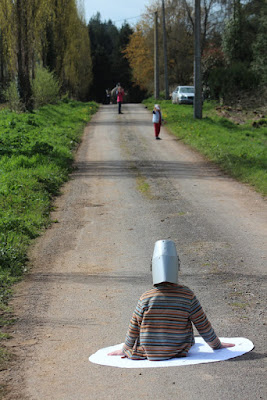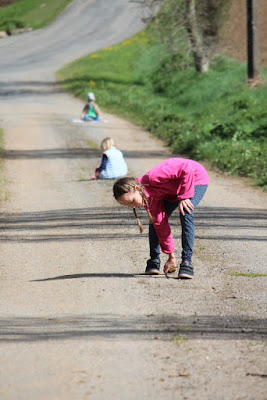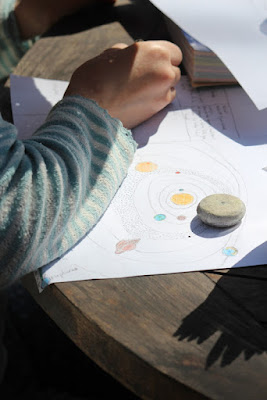 |
| Noah looks out on the solar system |
Space has often
featured quite highly in our homeschooling as at one time or another
it’s interested different members of the family. Perhaps you
remember the space station we made when Noah was obsessed with Tim
Peake? So it’s no surprise that we had a blast exploring the solar
system together recently.
Making Science Fun is easy when you have great hands-on activities to do as well as entertaining videos to watch and good textbooks. For the Solar System we were inspired by the amazing book Astronomy Lab for Kids by Michelle Nichols. The 52 activities inside our inspiring and challenging. Even better they use household supplies so you don’t have to run out and spend a lot of money on extra equipment – yay!
Making Science Fun is easy when you have great hands-on activities to do as well as entertaining videos to watch and good textbooks. For the Solar System we were inspired by the amazing book Astronomy Lab for Kids by Michelle Nichols. The 52 activities inside our inspiring and challenging. Even better they use household supplies so you don’t have to run out and spend a lot of money on extra equipment – yay!
Introducing the Solar System
To begin our study
of the solar system. I first asked the kids questions like what do
you know about our solar system? And, can you name any of the
planets? We then watched some videos suggested by national
geographic.
They were a fun mix with some songs and funny stuff mixed in.
Getting an idea of scale
Once we’d
familiarised ourselves with our solar system we got ready to do a
demonstration from the Astronomy Lab for Kids book called, Take a
walk on the rocky planets. The
rocky planets are Mercury, Venus, Earth and Mars – the four closest
to the sun. The other planets are gassy planets.
To do this demo we first had to make a giant circle to represent the sun. We followed the instructions in the book and taped together pieces of A4 until we had a big enough square to trace a circle with a 92cm diameter. We also followed the instructions to trace our circle. What we did was tie a 46cm piece of string to a pen and then held the string down in the centre of the paper while we used the pen to trace the circle. This was a great skill for the kids to learn.
To do this demo we first had to make a giant circle to represent the sun. We followed the instructions in the book and taped together pieces of A4 until we had a big enough square to trace a circle with a 92cm diameter. We also followed the instructions to trace our circle. What we did was tie a 46cm piece of string to a pen and then held the string down in the centre of the paper while we used the pen to trace the circle. This was a great skill for the kids to learn.
Next we made the 4 rocky planets our of play-doh. This was actually quite hard as they had to be really tiny, we’re talking mm. The kids really enjoyed trying and measuring them to see if they were the right size. We then taped our play-doh planets to pieces of paper with the names of the planets on them. Be careful if you do this to make sure the little play-doh planets are well attached or you might lose them like we did!
It
was now time to head outside. First we placed the sun right at the
far end of the (very quiet, read virtually unused and private) road
outside our house. Noah (8) sat down on the sun. Yes, he is wearing a
helmet as he decided he needed to dress appropriately if he was going
into space!
Lotta
(5) and I then paced out the 62 steps to get to Mercury. The steps
had to be approximately 60cm long. We used a tape measure to check.
Lotta sat down holding Mercury.
Maya (12) then paced out the 54 steps to Venus. Then I took 45 steps and placed the earth and finally my husband Frank paced a whopping 84 steps to be Mars.
This experiment was easy to set up because we had all the supplies on hand. It was fun to execute. I told the kids we were going on a space journey to see how far the rocky planets were from the sun. It was brilliant for getting an idea of the scale of things in space, not only the distances between the sun and the planets but also how giant the sun is compared to the rocky planets.
The kids really enjoyed not only the making part of this but also the demo.
Making a Model of the Solar System
Later
on that day we worked on three different models of the solar system
to help fix what they’d been learning in the kids minds.
This was really easy to adapt to different ages. For Lotta, I printed a picture of the solar system to colour in then traced it onto water colour paper because she decided she’d like to paint the solar system. She really enjoyed painting although it was a bit fiddly with some of the smaller planets. If I were to do this again with a five year old I’d probably scale it up so it would be better adapted to their fine motor skills.
This was really easy to adapt to different ages. For Lotta, I printed a picture of the solar system to colour in then traced it onto water colour paper because she decided she’d like to paint the solar system. She really enjoyed painting although it was a bit fiddly with some of the smaller planets. If I were to do this again with a five year old I’d probably scale it up so it would be better adapted to their fine motor skills.
Noah was lucky to have one of these. His sister has one too but she painted hers ages ago. It had been sat in his drawer for a bit and our morning’s activities really fired up his enthusiasm. He really enjoyed using our DK encyclopedia to make sure he painted all the planets accurately.
Finally, Maya drew the solar system in a circular fashion to show the planets in orbit round the sun. She added a scale across the bottom which shows distances between the planets. And also a section on the right of her paper to write a little bit about each of the planets. Again she used the DK Encyclopedia for information.
Classifying the Solar System
Our
final activity was a sorting game. This activity also came from
Astronomy Laboratory. I printed off about thirty pictures of our
solar system and the children took it in turns to put them in groups
based on their own organsiational systems. The other kids then had to
try and guess what their categories were.
I was pleasantly surprised at how much the kids loved this simple game to the point that they got up and started playing it again the very next day!
I was pleasantly surprised at how much the kids loved this simple game to the point that they got up and started playing it again the very next day!
Conclusion
Making science fun is easy if you use good books, hands on demos or experiments and let them express themselves when recording what they've learnt.
Exploring the Solar System has been a really memorable and rewarding experience so far. Yes, so far because we still have a whole host of other projects from Astronomy Labo we'd like to try out as well as some more fun looking documentaries to watch!
Exploring the Solar System has been a really memorable and rewarding experience so far. Yes, so far because we still have a whole host of other projects from Astronomy Labo we'd like to try out as well as some more fun looking documentaries to watch!














